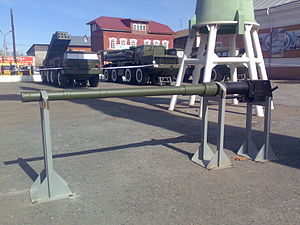| 100 mm gun 2A70 | |
|---|---|
 2A70 at the Motovilikha Plants museum | |
| Type | Gun-launcher |
| Place of origin | |
| Service history | |
| In service | 1990–present |
| Used by | See Operators |
| Production history | |
| Designer | KBP Instrument Design Bureau |
| Designed | 1980s |
| Manufacturer | Motovilikha Plants[1] |
| Produced | mid 1980s–present |
| No. built | 2000+ |
| Specifications | |
| Mass | 311.6 kilograms (687 lb) |
| Length | 3,943 millimetres (155.2 in) |
| Barrel length | > 3 m |
| Width | 281 millimetres (11.1 in) |
| Height | 404 millimetres (15.9 in) |
| Caliber | 100 millimetres (3.9 in) |
| Barrels | 1, rifled, no bore evacuator or muzzle device |
| Rate of fire | 8–10 rounds per minute |
| Muzzle velocity | See table
|
| Effective firing range | 3OF32: 300 m (980 ft)–4,000 m (13,000 ft) |
| Maximum firing range | 3OF70: 6,500 m (21,300 ft)[1] |
| Feed system | autoloader (shell); manual (shell and missile)[1] |
The 100 mm gun-launcher 2A70 (GRAU designation: 2А70) is a model of low-pressure rifled cannons designed in the Soviet Union by the KBP Instrument Design Bureau. Integrated into Bakhcha-U and Sinitsa turret modules, the gun equips the BMD-4, BMP-3, and BTR-90M infantry fighting vehicles. It is capable of launching the high-explosive fragmentation (HE-FRAG) 3OF32 and 3OF70 projectiles, as well as the 9M117 Bastion gun-launched anti-tank guided missiles (ATGM) and related systems.
China produces a similar gun used on the ZBD-04 IFV, using technologies licensed from Russia in 1996.[2] The VN20 has a version with a 100-mm gun.[3]
- ^ a b c "100mm 2A70". weaponsystems.net. Retrieved 2023-05-01.
- ^ "大国善谋,武器维护保养换过时产品,26年后中国却玩出先进步战车". Toutiao (in Chinese). 25 August 2022.
- ^ "The VN20 Is The Largest Combat Vehicle In Asia | 21st Century Asian Arms Race". 2023-02-11. Archived from the original on 2023-02-11. Retrieved 2023-02-18.